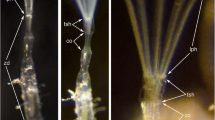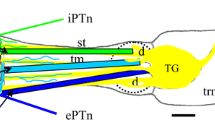Summary
The pathway of the tentacle nerves and the organisation of the peripharyngial nervous belt from which they arise, have been studied in Electra pilosa by silver stained whole mounts (Bielschowsky technique), and by ultrastructural investigation.
Each tentacle is innervated by four nervous fascicles without any differentiated glial sheath, running between the epithelium and the collagen layer which surrounds the muscles and the peritoneal cells in the internal tentacle canal. Three nerves are gathered underneath the three rows of epithelial cells forming the oral edge of the tentacle. The fourth nerve is in medio-dorsal location.
The oral epithelial cells show such ultrastructural adaptations in their general shape, in the density of their cytoplasm, in their ciliary apparatus reduced to a single cilium and in their close topographical and cytological relationship with the underlying tentacle nerves that it seems most probable they have a tactile function.
The analysis of the pattern of the peripharyngial nervous belt shows a precise organisation and the intrication of the connections which coordinate the tentacles and link the lophophore set to other pathways of general innervation.
Résumé
Le trajet des grands nerfs de la couronne tentaculaire et la structure du collier nerveux péripharyngien dont ils se détachent, ont été précisés chez Electra pilosa par des imprégnations argentiques in toto selon la technique de Bielschowsky et par une étude d'ultrastructure.
Chaque tentacule est innervé par quatre faisceaux nerveux, dépourvus d'envelope gliale, qui courent entre l'épithélium et l'assise collagène qui délimite le canal tentaculaire interne; trois sont rassemblés sous les trois rangées cellulaires épithéliales de l'arête orale du tentacule et le quatrième est médian-dorsal.
Les cellules épithéliales orales-latérales, par leur forme pédonculée, par la densité de leur cytoplasme, par leur cil unique et par leur relation topographique et cytologique avec les nerfs tentaculaires sous-jacents, présentent des adaptations structurales telles qu'il parait probable qu'elles assurent une fonction tactile.
L'examen du collier péripharyngien montre son caractère organisé et la complexité des connexions qui coordonnent l'ensemble des tentacules et relient le lophophore à d'autres secteurs de l'innervation.
Similar content being viewed by others
Bibliographie
Bronstein, G.: Etude du système nerveux de quelques Bryozoaires Gymnolémides. Trav. St. Biol. Roscoff 15, 155–174 (1957).
Gewerzhagen, A.: Beiträge zur Kenntnis der Bryozoen. Z. wiss. Zool. 107, 313–345 (1913).
Graupner, H.: Zur Kenntnis der feineren Anatomie der Bryozoen. Z. wiss. Zool. 136, 38–97 (1930).
Hiller, S.: The so-called nervous colonial system in Bryozoa. Nature (Lond.) 143, 1069–1070 (1939).
Lutaud, G.: Sur la ciliature du tentacule chez les Bryozoaires Chilostomes. Arch. Zool. exp. gén. 92, 13–19 (1958).
Lutaud, G.: Le «plexus» pariétal de Hiller et la coloration du système nerveux par le bleu de méthylène chez quelques Bryozoaires Chilostomes. Z. Zellforsch. 99, 302–314 (1969).
Lutaud, G.: The great tentacle sheath nerve as the path of the innervation of the frontal wall structures in the Cheilostomata Electra pilosa (Linné). Proc. 2nd Int. Conf. on Bryozoa (Durham) (1971).
Marcus, E.: Beobachtungen und Versuche am lebenden Meeresbryozoen. Zool. Jb. Abt. System., Ökol. u. Geogr. 52 (1), 1–102 (1926).
Marcus, E.: Über Lophopus cristallinus (Pallas). Zool. Jb., Abt. Anat. u. Ontog. 58, 506–606 (1934).
Silberman, S.: Untersuchungen über den feineren Bau von Alcyonidium mytili. Arch. Naturg. (Berl.) 72 (1), 265–310 (1906).
Smith, L. W.: Ultrastructure of Bryozoan tentacles. Proc. 2nd Int. Conf. on Bryozoa (Durham) (1971).
Author information
Authors and Affiliations
Rights and permissions
About this article
Cite this article
Lutaud, G. L'innervation du lophophore chez le Bryozoaire chilostome Electra pilosa (L.). Z.Zellforsch 140, 217–234 (1973). https://doi.org/10.1007/BF00306696
Received:
Issue Date:
DOI: https://doi.org/10.1007/BF00306696




